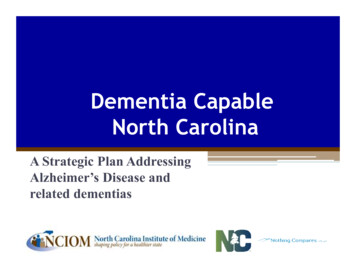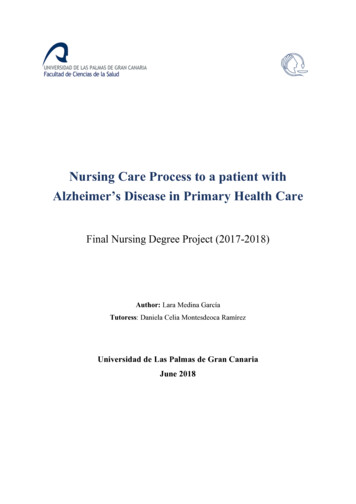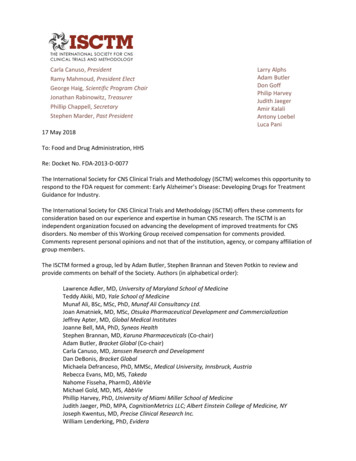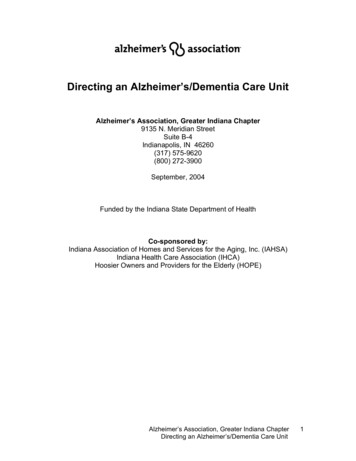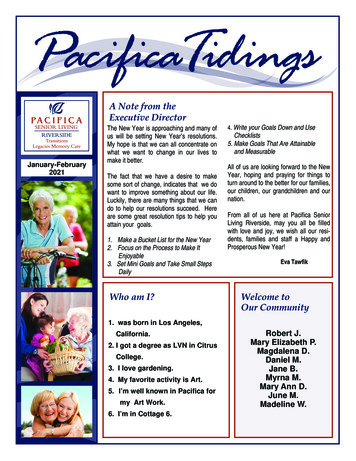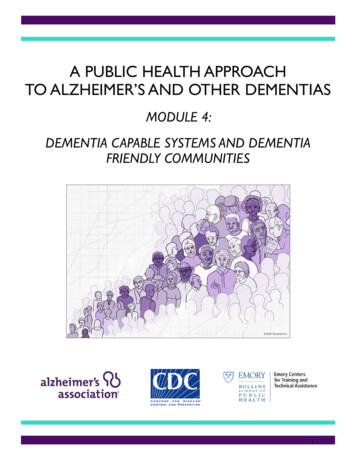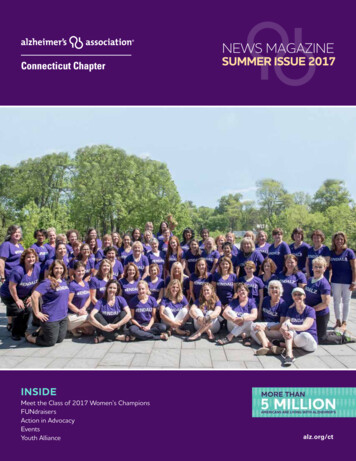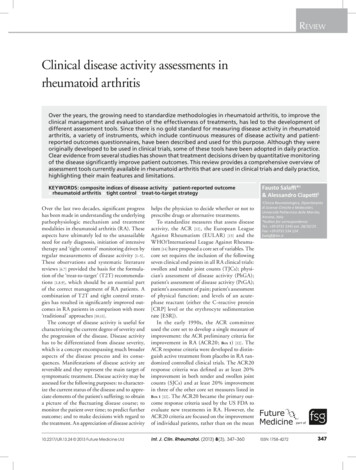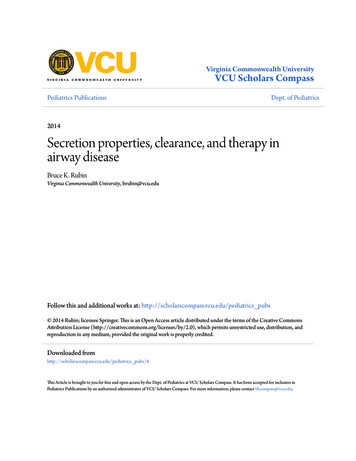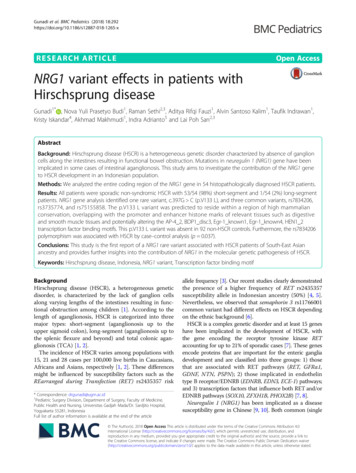
Transcription
2020KANSAS ALZHEIMER’S DISEASE PLAN
2020 Kansas Alzheimer’s Disease PlanTable of Contents1. Vision Summary2. Process for Preparing the Kansas Alzheimer’s Disease State PlanA. Executive OrderB. Members of the Task ForceC. CommitteesD. Survey3. Face of Dementia in KansasA. DefinitionB. Most DementiasC. DiversityD. DiagnosisE. Risk FactorsF. PrevalenceG. Costs4. Policies and RecommendationsA. Research and Data CollectionB. Rural KansasC. Safety and Legal IssuesD. Training and WorkforceE. Public AwarenessF. Access to CareG. Family CaregiverH. Care For All With Dementia5. Glossary6. Appendix
Vision SummaryAs Kansans prepare to address the challenges associated with Alzheimer’s and otherdementias, we want to assure that all Kansans are aware of and comfortable talking aboutaging issues and topics inherent to the aging process including Alzheimer’s and otherdementias; safety, legal and financial issues, preparation for end of life care, the need tocreate aging and dementia friendly communities, issues specific to rural areas of the state, adementia-capable workforce, and access to care.Process for Preparing the Kansas Alzheimer’s Disease State PlanExecutive OrderOn May 2, 2019 Gov. Laura Kelly signed an Executive Order creating the Alzheimer’sDisease Task Force. The purpose of the Task Force was to continue the progress of theAlzheimer’s Disease Working Group which met in 2018. The Task Force began meetingin August 2019 in Topeka. Members were from across the state, city and rural, and fromvarious backgrounds and connections to the disease. The report is due to Governor LauraKelly on January 13, 2020. (See appendix for full Executive Order)Members of the Task ForceMembers of the Task Force represent multiple industries and stakeholder groups including: The Alzheimer’s Association Psychologist in Geriatric Care Caregivers Elder Law Attorney Nursing Facility Silver Haired Legislature Assisted Living Law Enforcement Medical Care Provider Elected official Disease Researcher Area Agency on Aging Person with the diseaseCommitteesThe Task Force was made up of eight committees which met throughout the fall: PublicAwareness, Access to Care, Family Caregivers, Training and Workforce, Safety and Legal,Research and Data, Dementia Care, and Rural.SurveyIn the fall of 2019, for a six-week period, the Task Force conducted a survey to obtainpublic comment and input on the needs of Kansans. It was distributed widely to areasthroughout the state and to various types of stakeholders both to family caregivers andprofessional caregivers. A total of 1066 surveys were completed during that time. Thesurvey included multiple choice questions as well as open-ended questions so respondentscould share their own recommendations. For a full survey report refer to the Appendix E.Page 2
Face of Dementia in KansasDefinitionAlzheimer’s disease is a degenerative brain disease and the most common form ofdementia. Dementia is not a specific disease. It’s an overall term that describes a group ofsymptoms. Dementia is a general term for loss of memory and other mental abilities severeenough to interfere with daily life. It is caused by physical changes in the brain. Alzheimer’sis the most common type of dementia, but there are many kinds.Most Common DementiasAn umbrella term used to describe a wide range ofsymptoms associated with cognitive impairment.ALZHEIMER’S60% - 80%VASCULAR10% - 40%LEWY BODY10% - 25%FRONTOTEMPORAL 10%For a complete list of the most common types of dementia, please refer to Appendix B.DiversityKansas’ population is growing increasingly more diverse. The State of Kansas shouldencourage partnerships with multicultural coalitions, and other groups that representunderserved populations including rural communities, racial and ethnic minorities, veterans,members of the LGBT community, individuals with younger-onset Alzheimer’s disease,individuals with intellectual and developmental disabilities, and individuals with traumaticbrain injuries. These partnerships should be built in order to develop and expand dementiasupportive services to diverse individuals and families across the continuum of care(including, but not limited to, adult day care centers, physicians, home-based providers,assisted living communities, skilled nursing facilities, and specialized dementia care entities).It is imperative that the state provide access to diagnosis and quality health care for allindividuals affected by Alzheimer’s and other dementias.Page 3
DiagnosisThere is no single diagnostic test that can determine if a person has Alzheimer’s disease.Physicians (often with the help of specialists such as neurologists, neuropsychologists,geriatricians and geriatric psychiatrists) use a variety of approaches and tools to help makea diagnosis. Although physicians can almost always determine if a person has dementia, itmay be difficult to identify the exact cause.On average, people with Alzheimer’s disease live for eight to ten years after theirsymptoms begin. However, life expectancy does vary considerably depending on how oldthe person is along with other factors.Risk FactorsExperts agree that in the vast majority of cases, Alzheimer’s, like other common chronicconditions, probably develops as a result of complex interactions among multiple factors,including age, family history, genetics, environment, lifestyle and coexisting medicalconditions. Although some risk factors — such as age or genetics — cannot be changed,other risk factors — such as high blood pressure, diet and exercise — usually can beimproved to help reduce risk. Research in these areas may lead to new ways to reduce therisk of developing Alzheimer’s and other dementias.PrevalenceIn Kansas, 54,000 people age 65 years and older are living with the disease. It is estimatedthat the number will increase to 62,000 by year 2025 which is a 14.8 percent increase.Alzheimer’s is the sixth leading cause of death in all Kansans. It is estimated that there are 5.8million Americans living with Alzheimer’s. There are also approximately 151,000 caregiversand family members in Kansas who provide care and support for someone with the disease.With this expected increase in the prevalence of this disease, availability, and accessibility ofservices for individuals and families impacted are critical factors in dementia services.NUMBER OF PEOPLE AGED 65 AND OLDER WITH ALZHEIMER’S BY AGEYEAR2019202065-747,4009,00075-8422,00027,00085 24,00026,000TOTAL54,00062,000ESTIMATED PERCENTAGE CHANGE14.8%20182019 Alzheimer’s Disease Facts and Figures Report at alz.org/factsPage 42025
CostsTreating persons with the disease is very expensive. Currently, Alzheimer’s disease is themost expensive disease in America, costing more than cancer and heart disease. Thefinancial costs of Alzheimer’s for families and the government are enormous. The directcosts to American society of caring for those with Alzheimer’s and other dementias willtotal an estimated 290 billion. In 2019, Kansas spent 441 million Medicaid dollars onindividuals with this disease. These costs are expected to increase 21.7 percent by 2025.Given the cost of Alzheimer’s, it is easy to see how the financial burden of providing carecan wipe out a person’s savings. The burden is even heavier for those 7.3 percent ofKansans (over 211,000) 65 years of age or older who are living in poverty. The 29 percentof older adults living alone with Alzheimer’s disease, without family members to assist intheir care, are at particularly high risk of problems in both obtaining quality care and payingfor it. Individuals who are diagnosed with Alzheimer’s disease before they reach retirementage are also likely to face financial hardship due to loss of employment and inadequateinsurance. Alzheimer’s disease exacts a substantial burden not only on those affected buton their families, friends and communities as well. An estimated 151,000 Kansans provideunpaid care valued at nearly 2,173,000,000 for people with Alzheimer’s nances/cost-of-care.htmPage 5
Policies and RecommendationsResearch and Data CollectionImproving Research and Data Collection in KansasResearch that discovers a way to delay the debilitating symptoms of Alzheimer’s by just fiveyears could cut prevalence rates in half. Research is also the only means by which we willbe able to cure and ultimately prevent this tragic disease. Research efforts in Kansas haveaccelerated in recent years, advancing our understanding of Alzheimer’s disease, testingnew prevention and therapeutic strategies and developing new models of care. Theseefforts have set the stage for Kansas to become a national leader in fighting Alzheimer’sdisease. Action is still needed in the promotion of research and data collection in our state.Identifying new and effective treatments, cures, prevention strategies, and collecting datafor Alzheimer’s and other dementias are critical in addressing this public health crisis.Kansas research entities have been at the forefront of Alzheimer’s research, especiallyin the areas of causes of Alzheimer’s disease, models of care, treatment and prevention.Alzheimer’s disease research in the United States is funded primarily by the NationalInstitute on Aging (NIA) of the National Institutes of Health (NIH). In 1984, the NIAestablished five Alzheimer’s disease Centers (ADCs) across the country to advance clinicalcare. Kansas is one of only 21 states to have a nationally designated Alzheimer’s DiseaseResearch Center. Since receiving this designation in 2011, the University of KansasAlzheimer’s Disease Center (KU ADC) has made strides in preparing the state for the risingprevalence of Alzheimer’s disease. Researchers, clinicians, and educators at other stateuniversities and hospitals, including Kansas State, Emporia State, Wichita State, AscensionVia Christi Research and KU Wichita, among others, are also making an impact.Scientists in Kansas are hard at work to determine better ways to diagnose the disease anddevelop cures. The KU ADC is at the forefront of clinical trials, developing novel drugs andpartnering with others to test a variety of approaches to stop, slow, or prevent the disease.As one of 35 national sites to participate in the U.S. Department of Health & HumanServices, National Institute on Aging’s, Alzheimer’s Clinical Trial Consortium, the KU ADCbrings the most innovating and cutting-edge trial opportunities to Kansas.Ascension Via Christi Research (AVCR) has conducted clinical trials in Alzheimer’sdisease for the past 27 years. AVCR has participated in approximately 20 multicenterand investigator-initiated research studies testing various investigational medications totreat and prevent Alzheimer’s disease, including the currently FDA approved medicationsand Aducanumab, which will be taken to the FDA for possible approval in 2020, the firstnew medication to possibly be FDA approved in 19 years. ACVR is also working with theAlzheimer’s Association to develop a partnership between research, primary care andmental health focused on caring for the caregivers. Those caring for family members withPage 6
Alzheimer’s disease have their mental and physical health negatively affected by the stress.This will focus on quantifying data on caregiver stress and making appropriate referrals toprimary care and mental health professionals.Kansas scientists also have unique drug development efforts and have helped usher in anentirely new field of prevention science. In addition, researchers across the state areinvestigating how to best care for the increasing number of individuals with Alzheimer’s disease.New models of care are required to stem the rising tide of Alzheimer’s and better delivertoday’s treatments and tomorrow’s cure. A public health crisis of this magnitude requiresa unified community approach that aligns all the key stakeholders, with primary carephysicians at the forefront. Kansas researchers are beginning to test new models of carethat increase the reach of the highest quality caregivers, reduce costs and lower the healthburden on patients and families. More experts dedicated to fighting this disease are neededto transform our efforts to fight Alzheimer’s disease now and in the coming years. There isa critical shortage of physicians, nurse practitioners, and social workers. State universitiesin Kansas have developed training programs to successfully launch young physicians,scientists, and health care workers into the fight. Kansas needs a robust education andtraining effort to continue to develop the next generation of scientists, clinicians, and otherfrontline health care workers fighting the disease.Recommendations1. Public AwarenessIncrease awareness of Alzheimer’s research and clinical trials by promoting onstate websites (e.g. Kansas Department of Health and Environment (KDHE), KansasDepartment for Aging and Disability Services (KDADS), etc.). Ensure that the websitesinclude links to Alzheimer’s Association Trial Match, Ascension Via Christi Research,University of Kansas Alzheimer’s Disease Research Center, National Institute ofHealth, and other research centers/programs.2. Statewide Data Reporting SystemImplement a statewide data reporting system to improve data collection on theprevalence of Alzheimer’s and other dementias in Kansas. Data should be collected fromBehavioral Risk Factor Surveillance System (BRFSS), minimum data set (MDS) cognitiveimpairment data in nursing homes, hospital admissions, mortality, Adult ProtectiveService calls and cases, death certificate data, and Medicare cognitive assessment data.3. Expand AccessExplore approaches that would enable the expansion of clinical trials to satellitefacilities, including training of personnel, telemedicine, and remote videoconferencing approaches.4. FundingEncourage individuals to support funding for dementia research through localresearch institutions, the Alzheimer’s Association, and stat
Process for Preparing the Kansas Alzheimer’s Disease State Plan Executive Order On May 2, 2019 Gov. Laura Kelly signed an Executive Order creating the Alzheimer’s Disease Task Force. The purpose of the Task Force was to continue the progress of the Alzheimer’s Disease Working Group which met in 2018. The Task Force began meeting in August 2019 in Topeka. Members were from across the .

